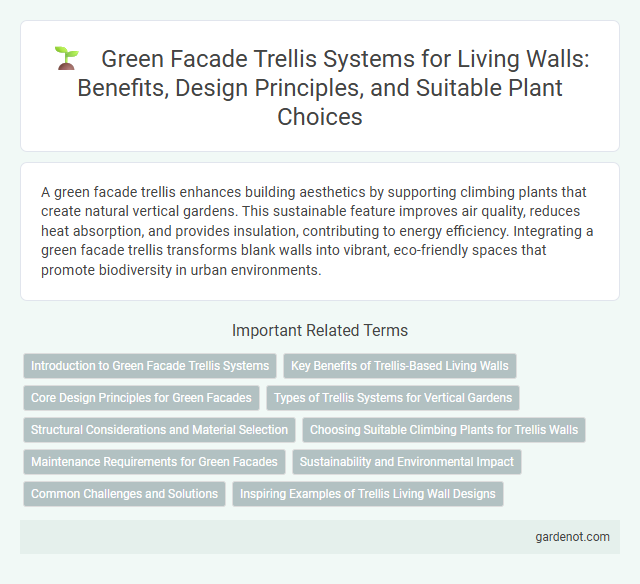A green facade trellis enhances building aesthetics by supporting climbing plants that create natural vertical gardens. This sustainable feature improves air quality, reduces heat absorption, and provides insulation, contributing to energy efficiency. Integrating a green facade trellis transforms blank walls into vibrant, eco-friendly spaces that promote biodiversity in urban environments.
Introduction to Green Facade Trellis Systems
Green facade trellis systems provide vertical support structures that enable climbing plants to grow and cover building exteriors, enhancing urban biodiversity and reducing heat absorption. Made from materials such as metal, wood, or synthetic fibers, these trellises improve air quality while contributing to natural insulation and aesthetic appeal. Proper installation and plant selection optimize the system's ecological benefits and structural longevity.
Key Benefits of Trellis-Based Living Walls
Trellis-based living walls significantly improve urban air quality by increasing oxygen production and filtering pollutants. These green facades enhance building insulation, reducing energy costs through natural temperature regulation. Their modular structure supports biodiversity by providing habitat for pollinators and urban wildlife, promoting ecological balance in city environments.
Core Design Principles for Green Facades
Green facade trellises follow core design principles that include selecting robust climbing plants compatible with the local climate and building facade, ensuring structural support capable of bearing plant weight and wind loads, and integrating efficient irrigation systems to maintain plant health. Proper spacing between the facade and trellis allows air circulation to prevent moisture buildup, while modular designs enable ease of installation and maintenance. These principles optimize the environmental benefits of green facades by enhancing insulation, reducing urban heat island effects, and improving air quality.
Types of Trellis Systems for Vertical Gardens
Green facade trellis systems support vertical gardens by providing structures for climbing plants to grow upwards, maximizing urban green space. Common types include tension-wire trellises, made of stainless steel cables for flexible plant training; panel trellises, constructed from wood or metal grids for robust support; and modular trellis systems, which offer customizable configurations to suit various building facades. Selecting the appropriate trellis type enhances plant health, structural integrity, and aesthetic appeal in green wall installations.
Structural Considerations and Material Selection
Green facade trellis systems require careful structural considerations to support the weight of climbing plants and resist environmental stresses such as wind and rain. Materials like galvanized steel, aluminum, or durable hardwood are preferred due to their strength, corrosion resistance, and longevity in outdoor conditions. Proper anchoring to the building facade and regular maintenance ensure the trellis remains stable and effective for plant growth.
Choosing Suitable Climbing Plants for Trellis Walls
Selecting appropriate climbing plants for a green facade trellis is essential to ensure robust growth and aesthetic appeal. Species like Clematis, Virginia creeper, and climbing hydrangea thrive on trellis structures due to their strong tendrils and adaptability to various climates. Proper choice depends on factors such as sunlight exposure, wall material, and desired maintenance level to achieve a sustainable living wall.
Maintenance Requirements for Green Facades
Green facade trellis systems require regular maintenance including pruning to control plant growth and prevent obstruction of light and air circulation. Irrigation must be monitored to avoid waterlogging and ensure the health of climbing plants. Periodic inspection of the trellis structure is essential to detect and repair any damage caused by weather or plant overgrowth.
Sustainability and Environmental Impact
Green facade trellises enhance urban sustainability by supporting vertical plant growth that improves air quality and reduces heat island effects. These structures promote biodiversity and natural insulation, leading to decreased energy consumption in buildings. Implementing green facades contributes significantly to carbon sequestration and stormwater management, advancing environmental resilience.
Common Challenges and Solutions
Green facade trellises often face challenges such as plant overgrowth leading to structural strain and inconsistent light exposure affecting growth uniformity. Proper maintenance routines, including regular pruning and choosing hardy, low-maintenance plant species, help ensure longevity and aesthetics. Installing adjustable support systems and monitoring growth patterns can further mitigate common issues to maintain a healthy living wall.
Inspiring Examples of Trellis Living Wall Designs
Innovative green facade trellis designs transform urban spaces by seamlessly integrating vertical gardens that enhance air quality and biodiversity. Notable examples include the Bosco Verticale in Milan, which utilizes a trellis structure to support thousands of trees and shrubs, creating a lush, energy-efficient facade. These living walls serve as dynamic ecosystems, providing natural insulation while promoting sustainable architecture in densely populated areas.
Green facade trellis Infographic

 gardenot.com
gardenot.com